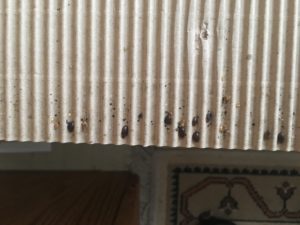The Collectabed’s prime feature (inspectable cardboard) offers bed bugs no place to hide except for excellent disposable harbourage just under the mattress. The disposable harbourage consists of corrugated single face cardboard covered by a thin raw wood panel. The panel opens like a book cover to reveal whatever bugs are hiding in the cardboard.
An alternate method of using the Collectabed is to surround the top of the box spring with the cardboard sandwich mentioned above. In this method the bugs come out of the box spring, take a blood meal, and then hide in the disposable cardboard. We have been, experimentally, successful in getting rid of bed bugs in a suite, including the infested box spring, by regularly disposing of the cardboard. Impressive. There is tremendous potential here.
I have noted that the distribution patterns of the bugs are altered from typical presentations in both of the above versions of the Collectabed. Normally there are specific locations on a bed that have the lion’s share of bugs and this location changes depending on the location of walls, windows and type of bed. Areas of the bed that are exposed to the middle of a room are typically least favoured. The Collectabed seemed to consistently change that presentation with more bugs harbouring in the open area. The “hot spots” remained attractive but only 60% of the bugs harboured there. The rest were scattered over large portions of the remainder of the bed. As such a single monitor could, at best, collect 60% of the bugs in these beds – roughly the same observations Naylor noted in the collectabed mini study.
Another interesting observation was that the bugs did not aggregate into groups like a normal infestation. The bugs tended to line up like they had purchased condos – each individual bug harboured in their own corrugation. I would think less than 20% of the corrugations contained more than one bug. As such there is a lot to learn about what causes bed bug aggregation – they are not attracted to each other regardless of circumstance. It would be interesting to slowly increase the size of the corrugations to see how that changed the “condo” effect of the standard Collectabed. There is much we do not understand about why bed bugs aggregate, or not, and the Collectabed would be an excellent experimental tool to to parse out that question.
Furthermore, you will note in the photo that there is evidence of bed bugs in many of the corrugations but no bed bug. Apparently the bugs don’t return to their harbourage in a Collectabed. Interesting. Again more to learn.
